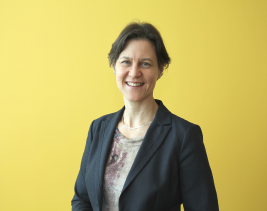Expert Voices
“Middle-income countries face a set of global challenges that require joint action”

Around the world, 107 nations rank as middle-income countries. They generate a per capita income from about $1,000 to more than $12,000 per year and together, they are home to three quarters of the world population. Ahead of the UN General Assembly High-level Meeting on Middle-income Countries on 11 May, UN DESA’s Cornelia Kaldewei explains the issues that middle-income countries face today.
- 1. What are the biggest challenges facing middle-income countries today?
“Middle-income countries are a large and heterogenous group. They differ widely in their development needs and challenges, and in their capacity to mobilise domestic and external resources. For example, the national poverty headcount ratio measured at $3.65 a day (in 2017 PPP) ranges from less than one per cent to over 75 per cent. If we divide the group into lower middle-income countries and upper-middle income countries, according to the World Bank methodology, we find average poverty levels of 34 per cent in the former and 10 per cent in the latter. However, the highest poverty rate in the upper-middle income group is 40 per cent – above the average in the lower-middle income group. This is just one example of the great variability of living conditions. The picture is similar when it comes to economic indicators such as investment ratios, export concentration or research and development.
Despite their many differences, middle-income countries face a set of global challenges that require joint action. Multiple and overlapping current crises – including the global cost-of-living crisis, food insecurity, growing sovereign debt burdens, high geopolitical tensions, and the worsening climate crisis – have amplified challenges and constrained countries’ resources to address them. At the same time, their economies are still deeply scarred from the COVID-19 pandemic, and many face difficulties in accessing concessional finance.
Middle-income countries must design and implement coherent and consistent policy measures that address urgent needs in the short-term and strengthen sustainable development trajectories in the long term. This includes difficult transitions towards a growth model that is driven by innovation and productivity growth, and that facilitates an inclusive green transition.”
- 2. How can the international community support middle-income countries in overcoming challenges to sustainable development?
“In today’s highly globalized and interconnected world, national development efforts depend more than ever on an enabling international economic environment. This includes coherent and mutually supporting world trade, monetary and financial systems, as well as appropriate mechanisms for the global transfer of knowledge and technologies. There is an urgent need to build on ongoing multilateral efforts to address the growing problem of sovereign indebtedness, including for middle-income countries.
Support for middle-income countries must be tailored to their specific needs and vulnerabilities, in line with national development priorities. While concessional finance will remain an important tool, especially to address urgent humanitarian and social needs, a broader range of financial instruments can help countries with necessary structural transformations. Knowledge transfer, capacity building and policy support are equally important to overcome development constraints, and to achieve the environmental dimension of development, together with the economic and social dimensions.
The UN development system is engaged in all these areas at the country, regional and global levels. This includes work by UN DESA on the topic of ‘beyond GDP’, which the Secretary-General has highlighted in Our Common Agenda, and in support of discussions of a Multi-Dimensional Vulnerability Index for SIDs.”
- 3. Describe the ways in which middle-income countries are collaborating to accelerate the implementation of the 2030 Agenda.
“Middle-income countries are major drivers of the global economy. They can be important regional growth poles, including through trade and investment linkages and workers’ remittances, and by cooperating across borders on regional and global issues such as food and water security, transport, energy and climate. Middle-income countries have contributed little to climate change in the past, but several of them have recently become significant emitters of greenhouse gases. Some have made ambitious climate commitments, and their green transition will be key for achieving the Paris Agreement target of limiting global warming to 1.5°C above pre-industrial levels.
Middle-income countries have expertise and knowledge that can help other developing countries, and a growing number is dedicating resources through their own assistance programmes. South-South cooperation can build on development experiences to support countries facing similar challenges and facilitate joint efforts to address regional and global issues. Triangular cooperation, which can include donor countries and/or international organizations, can help mobilise additional resources.”
For more information: UN General Assembly High-level Meeting on Middle-income Countries
 Welcome to the United Nations
Welcome to the United Nations